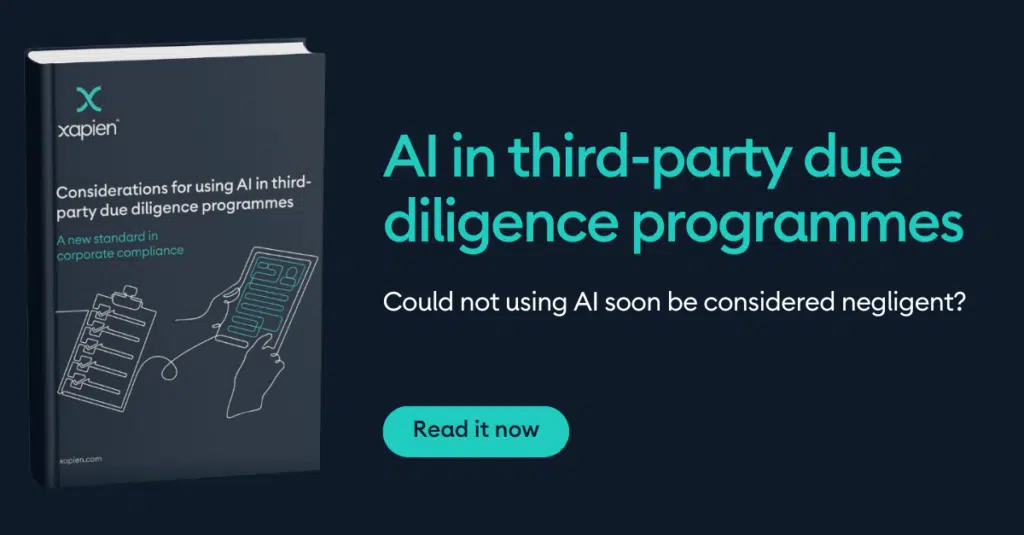
Third party due diligence:
What’s an adverse media search, and why is it important?

In today’s fast-paced world, where information is circulated online at lightning speed, companies can’t afford to miss red flags about third parties found online. That’s where an adverse media search, also known as adverse news screening, comes in. Adverse media searches involve looking for and analysing negative information about individuals and entities. This article delves into what adverse media searches include, why they’re evolving and how compliance teams can keep up.
What is an adverse media search?
While database checks and registry searches tick boxes, it only gives a partial view. Adverse media screening is how compliance teams go deeper into a subject’s risk profile. Adverse media searches involve a systematic search for negative news or adverse information about a person or entity. This includes information on criminal activities, regulatory breaches, financial misconduct, and any other news that could damage a company’s reputation or financial standing. The screening process uses various sources, including news articles, blogs, press releases and more to gather relevant information.
Why are adverse media searches important?
In today’s complex world, accessing contextual information from news articles, press releases, company websites, and other online sources is crucial for understanding individuals and entities beyond just a watchlist status or a sanction. Just because someone shows up as a “no hit” in a screening tool doesn’t mean they lack a risk profile; it simply means they aren’t listed in that database. Adverse media searches enable compliance teams to build a more rounded risk profile.
Adverse media searches are essential for firms to manage regulatory and financial risks while safeguarding their reputation. For example, one firm with a large client base missed a compliance issue in their level one due diligence report. Their strict methodology relied on specific Google search strings and limited review of search result pages, which led to this oversight. In another instance, a financial institution was fined £270 million for overlooking a regulatory issue that didn’t appear in a structured database but had enough information online to raise red flags about that subject’s connections.
How adverse media searches are evolving
Adverse media screening often relies on a strict and manual methodology that can’t be scaled. Some compliance teams must adhere to page limitations, which are often put in place to conserve resources. But that makes finding the information you need a complex challenge. Manually sifting through thousands of results to review only a few isn’t practical, especially when names aren’t unique identifiers anymore.
Searching for “Chris Green” yields 1.7 billion results, but this isn’t helpful since many people share that name. Searching for “Chris Green of Xapien” gives fewer results but overlooks previous career history. In short, internet searches are broad but incomplete, and while structured databases offer more data, they only provide partial insight. You need information from both sources, but triangulating between them is a labour-intensive task.

The shift to AI for negative news screening
AI is transforming how compliance teams conduct adverse media searches. While it’s nearly impossible for a human to sift through thousands of news items, AI can do it in minutes. However, not all AI-powered solutions are the same, and some tools may lack key capabilities. Here’s what to look for…
Name matching
Your subject might be referred to by nicknames, aliases or alternative spellings. Look for a tool that offers name matching and minimises false positives as a result.
Translation
Multilingual capabilities are essential in today’s global landscape.
Scalability
You’ll save yourself time if you can define search parameters, search depth, and result filtering.
Reporting
You don’t want to waste time sorting through results. Look for a tool that sets them out for you, so you can move on to the decision-making stage.
Traceability
Traceability is essential for audits and compliance. The best tools will visibly trace every piece of information they deliver back to the original source (even at the sentence level).
Explainability
This is vital for compliance, so you can demonstrate to the regulator how you concluded accepting, or not accepting, a partner, client or donor using the tool.
Summarisation
When faced with pages of information that need distillation, you require a tool capable of summarising this substantial content into easily digestible and categorised sections.
Why use Xapien for adverse media searches
Xapien overcomes the traditional challenges of adverse media checks while enhancing the speed and quality of research findings. It has all of the capabilities mentioned above (and more).
Breadth of information
Xapien’s AI-driven system goes beyond traditional keyword searches. It searches a vast range of data sources, including news articles, media publications, blogs, public records, and sanction lists. What sets Xapien apart is its ability to not just scan texts for risk words but to “read” and extract potential risk information like a human analyst would.
Accuracy and relevance
Traditional keyword-based searches often result in false positives, where irrelevant information is flagged as a risk. Xapien’s Natural Language Processing (NLP) allows it to consider context, negations, and even slang meanings of words. This means it can differentiate between a casual mention of “court” in a sports context and a legal issue, providing more accurate and relevant results.
Standardisation and consistency
Xapien ensures a consistent and standardised NNS process. Unlike manual research, which can vary from one analyst to another, Xapien’s results are uniform and free from the biases of human interpretation. This standardisation ensures trustworthy results and helps organisations maintain compliance with regulatory requirements.
Efficiency and speed
While manual research can take hours or even days, Xapien can generate detailed, sourced reports in minutes. This enables organisations to onboard clients, donors, or partners much faster while ensuring a thorough NNS process.
Multilingual capabilities
In today’s globalised world, the ability to conduct NNS in multiple languages is essential. Xapien can translate results from over 130 languages, ensuring that organisations don’t miss risks in non-English sources. This capability is particularly valuable when dealing with international subjects or entities.
Full audit trail
Xapien provides a comprehensive audit trail, documenting every step of the NNS process. This not only ensures transparency but also serves as concrete evidence of due diligence.

Check out this blog on how to gain trust in AI for research. Or if you’re ready to get started, book a demo with our team to see Xapien in action.

Monthly learnings and insights to your inbox
Xapien streamlines due diligence
Xapien's AI-powered research and due diligence tool goes faster than manual research and beyond traditional database checks. Fill in the form to the right to book in a 30 minute live demonstration.